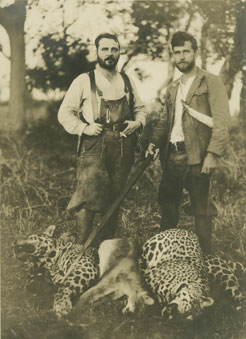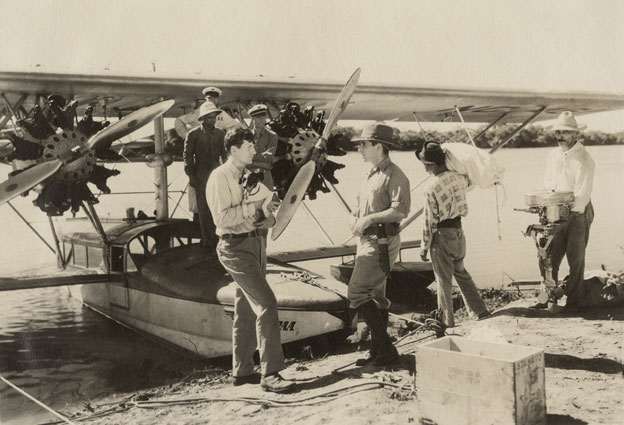
This page includes information that may not reflect the current views and values of the Penn Museum.


MATTO GROSSO
EXPEDITION, Inc.
Sound Moving Pictures : Science : Exploration

Matto Grosso is an expeditionary travel film, in that it depicts aspects of the expedition and a mix of indigenous people with that of travel, hunting, animals and nature.
Keeping in mind that the term ethnographic film was not yet coined, proportionately half of this film deals with the São Lourenço Bororo people.[1] As we have seen from the Johnson quotes above, the goal of the expedition and film were to capture a record of what the members considered to be the aboriginal or primeval state of being, in what would today be considered a form of “salvage anthropology”.
To add substance and legitimacy to the project Penn Museum was asked to provide an ethnographer to provide context to the documentation of the indigenous people of the region, the Bororo, and, also, the more remote Xingu River peoples.[2] The University of Pennsylvania and its Museum sent Dr. Vincenzo Petrullo, who had done fieldwork with the Delaware (Lenape) and Algonquin nations.[3] (Despite this, the Museum does not appear anywhere in the credits, nor does Petrullo by name).
When the expedition team and film crew arrived in Mato Grosso, Petrullo quickly discovered that the São Lourenço Bororo were not as remote or un-contacted as he had hoped, and, therefore, pursued much of his own field work further up-river with the Yawalapiti and in other more remote Xingu villages of the upper Xingu River Valley. (Petrullo, 1932) In Matto Grosso, we can hear sync sound footage of Bororo people speaking, (and Petrullo, speaking Portuguese with a translator) making Matto Grosso certainly the first film recording of non-Western people containing sync-recorded speech.[4]
Given the comments by Floyd Crosby, had there been a script in advance, the film might have become a complete feature film akin to Tabu, with a traditional narrative story line. As it turned out, there was less planning and leadership and much more improvisation in the production of Matto Grosso. Even so, in Matto Grosso, some staging is quite apparent. This may make some sense given Crosby’s recent experience working on Tabu under Robert Flaherty, who is known to have staged many scenes in his documentary films beginning with Nanook of the North, or the almost entirely fictional Tabu, as written by F.W. Murnau.
The lead character in Matto Grosso is a Florida “cracker”[5] guide, “Uncle” George Rawls, (his real name), who was hired to play an explorer, and appears throughout as a kindly man who makes friends with a Bororo boy, and sets up a temporary trading post.[6] A New York Times review mentions the “staged scenes” in a jaundiced remark or two. The inclusion of non-indigenous actors and expedition members, it could be argued, removes the illusion of an “objective” camera eye, one might even argue, unintentionally adding a reflexive aspect. (By contrast, note that Flaherty himself never appears in one of his own films.) Films such as Matto Grosso have, in any case, may become important archival documents to these source communities, both as personal history and as primary source materials. On the other hand, the article by Edgar Teodoro da Cunha and Sylvia Caiuby Novaes (2012) stress their consternation at the discovery that Xingu houses somehow appear in the film as if they were the dwellings of the Bororo, possibly because they seem to make more visually dramatic lodgings. This was more of a concern to both authors than their Bororo audience as it turns out, but begs the question of the degree of staging in the film in general.

Contrasting the gripping, somewhat sensational tales in the newspaper accounts (most of which actually occurred) with the more sedate tone of the film is notable. Highlighted in the many New York Times accounts (written by Newell and others) are alligator attacks, how to prevent a jaguar attack at night, the mysteries of earlier disappeared explorers, an anaconda bite that forces the return of a crew member, capsizing canoes, gunshot hunting wounds, and “tribal disputes narrowly diverted by fast thinking crew members”. None of these appear in the film, as one might expect in true adventure-expedition film of the time, as it did in Congorilla (1932) or earlier Africa speaks! (1930).

After Matto Grosso, it would be many years before the attempt was made to produce another field documentary sound film. The seminal visual anthropologist and filmmaker Jean Rouch made an early attempt by using a non-sync “Zougoubi magnetophone” sound recorder when visiting his mentor Marcel Griaule on the cliffs of Bandiara in Mali during in his fieldwork with the Dogon. As a result, there is some sound with the footage, as heard in the film, Cimetiere dans la falais (1950), mostly consisting of funerary dirges and chanting (Berthe, 2009). Rouch was otherwise innovative in his use of participant narration in post-production, as in Moi, un Noir (1958), Les Maitres Fous (1954), and Jaguar (1955). However he did not work with true sync gear until the 1960’s, working with his Nigerien sound man, Damouré Zika. The next American effort was Bitter Melons by John Marshall, for which sound was recorded in 1955, although the film itself was not edited and released until 1972 (Foley 2009).
All of the later ethnographic sync sound films were made using 16mm cameras variously jury-rigged to sound gear (Foley 2009) or as in Rouch, making experimental use of amateur and semi-professional technologies newly erupting in the market. It is not so surprising, given the budgets and technical wherewithal later available to anthropologists, often working alone, that the standard usage would be 16mm. As Robert Gardner (2006) remarks on his filming of Dead Birds in 1965, he read the Kodak Filmo and Bolex manuals and somehow figured it how to make films. What makes Matto Grosso such a singular example is that it had a Hollywood crew using standard Hollywood 35mm gear, so early, and in unusually remote circumstances in the field.
It is not entirely clear who made arrangements for editing the footage that became Matto Grosso, but at some point, distribution arrangements were made with Sol Lesser of Principal Pictures. The Principal Pictures catalog consisted of mostly Tarzan and other exotica/adventure films, and the company’s principal, Lesser, was later the controversial editor of Sergei Eisenstein’s film, Thunder over Mexico (1933), (Meir 2005).
We do not know very much about the exhibition history of Matto Grosso, which as edited runs circa 49 minutes, a theatrical short. Newspaper advertisements at the time reveal that the film premiered in January 16th, 1933 at the RKO Cameo Theater in Times Square, NYC, (NYT 1933) was generally well reviewed by the New York Times, and had another exhibition at the Seventh Avenue Roxy Theater in a shortened version together with the film titled West of Singapore, a romance set in the Pacific. In one N.Y.Times advertisement the film is advertised with the subtitle The Land of Green Jungle Hell, a reference to a book written by Julian Duguid, in which Sasha Siemel had appeared as a famous hunter-explorer. This is clearly an attempt to draw the adventure film audience.
Johnson later had several 16mm prints made for screenings at the Museum, (the last remaining Museum copy was recently restored and preserved under a grant from the National Film Preservation Foundation). In addition, the film and perhaps other footage was screened at the Archaeology Society of Washington, and this occasioned a report in the Washington Post that states that this is the “first sound moving pictures ever taken of primitive people” and notes that the audience can hear “their language recorded on the sound film” (WP 1933).
As with all of the films produced directly by the Museum, the film footage of Matto Grosso was reedited and repurposed several times. Two later films were created by the Museum with producer and filmmaker, Ted Nemeth, from the footage shot in Brazil in 1930, both narrated by Lowell Thomas: Primitive Peoples of Matto Grosso: The Bororo (1941) and Primitive Peoples of Matto Grosso: The Xingu.(1941). Today we cringe at the attribute “primitive” as a descriptive, the narrative of these films reflects the cultural prejudices of their times.
We now know from reading Petrullo’s papers that the scripts for these latter films were likely drafted by Vincenzo Petrullo, not long before he was dismissed by the Museum. In a very peculiar twist, Petrullo’s unpublished manuscript on the expedition reveal a strangely ethnocentric set of ideas about the Bororo, in direct contradiction to the teaching of his mentors. In reading this text, it is hard to imagine that Petrullo was the student of the very forward thinking and influential Frank G. Speck. None of Speck’s teaching on equality and cultural relativism is reflected in this ill- conceived work. It is the non-academic E.R.F. Johnson who reveals more enlightened thoughts, who does not rush to judge, for example “How do we measure the fitness of a race? Especially when we devise our own scales” (E.R.F. Johnson, in Petrullo, 1941). Such concepts are assumed today, thanks in part to the dissemination of Boas and Speck’s work, the civil rights movements and other historical phenomena, but were less usual in 1931.

The three films provide a fascinating contrast in how the perspective of the writer and of the editor can utterly change the depiction of the peoples filmed. The same footage is used in the earlier and later Bororo films, but with a completely different tone and set of meanings. A case in point can be seen in the sequence of Matto Grosso in which the narrator states the following after the presence of a jaguar is noted in the area, and religious preparations are made:
“Much of their complicated symbolism was beyond our understanding…A profound religious significance lay behind the ceremony. Among them we began to realize outward forms and gestures played a more important role than simple action…Across the village another group performed a second and related dance.. not until this was done was the slightest effort made toward any actual preparations for a hunt.”
Contrast this with a narration sequence from Primitive People of Matto Grosso, the Bororo:
“Formerly the arrival of strangers would have been received with suspicion and the men would have seized their bows and arrows but in recent years the Bororo have been pacified by the Brazilian government. The Bororo are a large heavily built people with a strong Mongoloid appearance, which is emphasized by their custom of shaving of the eyebrows and the temples. Formerly they went naked, but many of them now possess scraps of filthy cloth which have been obtained in trade for some bow or arrow.”

Interestingly, almost all of the recorded synch sound was removed from the later film, as if to imply that it is preferred that the omniscient narrator take control. The one sync sequence, a man describing the manufacture and use of bows and arrows (2:00 in length), stands out awkwardly as a result. Perhaps the estimation of the audiences of their day and desire to make a popular film was the motive, all of which makes the generally more enlightened tone of the earlier Matto Grosso more remarkable.
[1]Alison Griffiths defines ethnographic film as “actuality films featuring native peoples that were produced by anthropologists, commercial, and amateur filmmakers alike” (2002, p. xixx) This being said, many of the early films that depict indigenous people or source communities are partially staged at best (Nanook of the North (1922), Grass (1925) Moana (1926),) and heavily fictionalized at worst (as in Tabu,(1931) Congorilla, (1932) or Africa speaks (1930). Regarding visual anthropology research done purely by anthropologists. Emilie de Brigard (1977) states that the very first ethnographic films were made by Felix-Louis Regnault in 1895, this of a Wolof woman involved in an exhibition in Paris, using “celluloid roll film” Regnault throughout his career petitioned heavily for an anthropological film archive. One strikingly early experiment in the use sound filmmaking was made by anthropologist Rudolf Poch in South Africa, in which he filmed a Ju/’hoan man speaking in to a wax cylinder phonograph cone (Bushmen Speaking in to the Phonograph, 1908). Another attempt at sound with filming was made by anthropologist Franz Boas. He filmed Kwakiutl dances and singing in Washington state in 1930, using a 16mm camera and a wax cylinder recorder. Sadly the wax cylinder recordings were stolen from the trunk of a car so Boas did not complete, publish or distribute the film.
[2]The partnering concept also had precedence. There was a brief collaboration between Harvard’s anthropology department and Pathe´ films in the 1920’s that led to a series of five silent anthropology/travelogue films, one of which can be found in the Library of Congress.
[3]Representing the zoological mission was James A.G. Rehn from the Academy of Natural Sciences of Philadelphia.
[4]A conundrum is presented by the film Africa speaks! (1930), pre-dating Matto Grosso. The film purports to contain speech by Africans, but in the one clearly sync sequence an Efe man says a single word as he gobbles salt in a (painfully) staged scene, played for racist comedy. Hoefler pretends to understand Efe, “translating” ten words for the one spoken, throwing even more into doubt. The remainder of the film sound generally consists of Paul Hoefler and Harald Austin hamming before animal safari scenes, and non-sync music and effects. Though it is the first sound film made in Africa, Africa speaks is essentially a drama film that has no connection with the field of anthropology, and is consistently demeaning, as noted by Amy J. Staples.(2006). So little of the film is factual that it is more akin to ethnofictions like Congorilla, but for the appearance of the two white men, playing themselves. We are therefore loathe to consider it a documentary.
[5]“Cracker” as a term refers to cowboys of the Florida panhandle in this case.
[6]It should however be mentioned that there is much implication that this is a first contact situation, which is absurd on the face of it since the character of the Chief speaks Portuguese fluently in several scenes. It is not clear if the women in the film were asked to remove their shirts as if to appear more “primitive” or primeval. In some photographs in the Penn Museum Archives the women of the town seem to be wearing western dress.
